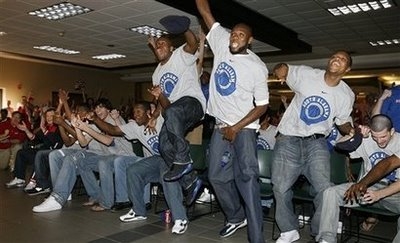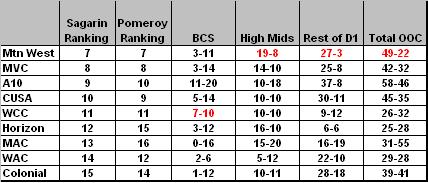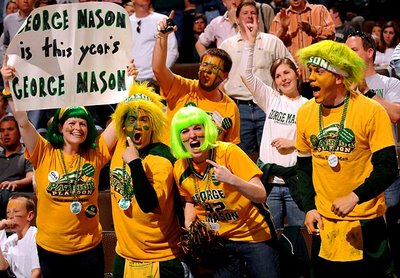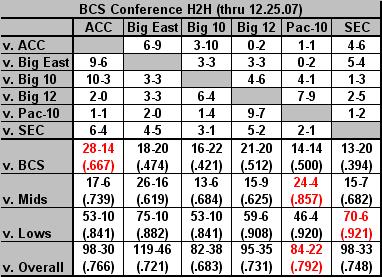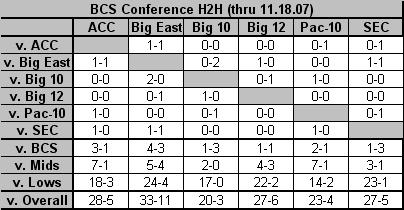09.03.09 Fast Breaks
Posted by rtmsf on September 3rd, 2009On the eve of college football’s start… let’s get caught up on the news and notes from the last week in roundball.
- Preaching to the Choir. Gary Parrish wrote an article that was ostensibly about the A10’s financially-motivated decision to move from its ancestral home of Philadelphia to its Sun Belt environs of Newport News, Virginia, but morphed into a scathing critique of the rapidly increasing revenue gap between the power conferences and the mid-majors. We liken this a little bit to what has happened in major league baseball over the past twenty years or so. It’s not an issue of there once being equality where now there is none; it’s more an issue of relative inequality being much larger than it ever has been (and only increasing). The Yankees and other major market franchises in MLB always had more money to spend on players, marketing, etc., and were summarily rewarded with larger media deals and ticket prices. This is similarly true for the power conferences in football and basketball. But in the modern era of 100-million dollar contracts for baseball players and billion-dollar contracts for media rights, what we’re witnessing is an acceleration of the revenue gap between large and small to a future point that is completely unsustainable. As an example of the disparity, the $2.2B television contract that the SEC has with ESPN is probably worth more than the contracts of every mid-major league in existence has ever had, combined. Seriously. As Parrish points out, this sort of exposure leads to recruits, and the cycle starts all over again. We’re really uncertain as to how the NCAA plans to deal with this over the next decade, but if we know anything about the entity at all, we’re betting that they’ll be completely behind the curve when something happens.
- Vegas Watch: Big 12 Preview. We mentioned this in a previous FBs, but Vegas Watch is leading an exercise previewing each of the six BCS conferences using last year’s Pomeroy rankings, this year’s incoming recruits, and the sharp eye of his respected cronies (Money Line Journal and Sports Investments). He invited RTC along for the ride this time around, and we tried to provide some value where we could. Keep an eye out for the remaining installments over the next several weeks. (note: not even a regression analysis is needed to determine KU is #1 in the Big 12)
- Get Creative, SEC Schools. Look, it’s not every year that a player named Nimrod Tishman comes into your league as a freshman, assuming that the NCAA clears his amateur status in the next few weeks. But Billy Donovan’s Florida Gators picked up the 6’6 Israeli to replace Nick Calathes and you should expect to see his curious name all over the place next season. So here’s our request of the other 11 SEC schools – get creative. Come up with some really clever signs and chants for when Florida visits your house this winter. If we hear a school derisively chanting his first name with no further thought or effort put into it, we’re going to be extremely disappointed. Come on, UK and UT fans, we know you’ve got something up your sleeves – an opportunity like this only comes around once a decade.
- SI’s 25 Things We Miss in Basketball. This wasn’t exclusively a list of college basketball memories, but the ones chosen by Grant Wahl, Seth Davis and others were exceptional. It’s not every day we can honestly say we learned something completely new about the modern era of CBB, but the piece about Bo Ellis designing Marquette’s national title year “untucked” jerseys indeed was (image here). It was so ugly that the NCAA banned it a few years later. We also enjoyed the pieces on great team nicknames, Len Bias and the SEC in the 80s. Give it a read. You won’t regret it.
- Closing Out Pitino/Sypher. An awful lot of bandwidth was used writing about the Pitino/Sypher Scandal, and presumably there’s more to this story coming down the road. But the best piece we read last week was this one on CNNSI by Pablo Torre, who attempts to describe Pitino’s inner circle and how intertwined they all are. The worst one was this abomination by Jason Whitlock. Then there was this hard-hitting interview from WLKY in Louisville…
- Comings and Goings. J’Covan Brown was cleared to play at Texas this season. Ditto with Mississippi St.’s John Riek, who will sit out the first nine games of the season over extra benefits. Pitt’s Gilbert Brown, on the other hand, will be sitting out the fall semester due to academic troubles. South Carolina picked up a heckuva transfer in walk-on Malik Cooke, who averaged 9/5 for Nevada last season. Darryl “Truck” Bryant’s legal troubles don’t appear to be too burdensome – he’ll face no jail time after leaving the scene of an accident and striking a WVU student with his vehicle in separate incidents this summer. What’s that get you under Huggins? A one-game suspension? Finally, in the let’s-keep-our-fingers-crossed dept., BYU’s Dave Rose got a clean bill of health after his pancreatic cancer surgery earlier this summer. He’s hopeful that he’ll be back on the court this season (his next scan is in two weeks).
- Quick Hits. John Wooden: On death, penises and politics. Calipari: disappointed in Memphis penalties. NCAA Selective Enforcement: we need as many people writing as many articles about these inconsistencies as possible. Tom Crean: Marquette HOFer. Kevin Stallings: forgoes $100k raise for team trip Down Under. Greg Paulus: starting QB at Cuse. Goodman: impact transfers for 09-10. Patrick Christopher: the new JJ Redick. Eric Bledsoe: better than Wall? Scout: summer all-americans and class of 2011 rankings. Delaware: looks like NFL parlays or nothing at all, folks. Arizona: can the Cats scratch their way to 26 in a row? Billy Clyde: the least hirable coach in America? FIU: caves, will play UNC after all. Jarvis Varnado: heading home, but what caused his sudden illness? Ed Davender: ticket scammer. BBall Prospectus: careful slurping that class of 09 just yet… Nebraska: inventing new ways to hold scholarship players. Teddy Dupay: 30 days in jail. NCAA Ethics: John Beilein is the head man, and here’s what coaches want to see. Bank Robber Recruit: Anthony DiLoreto signs with Utah St.





























